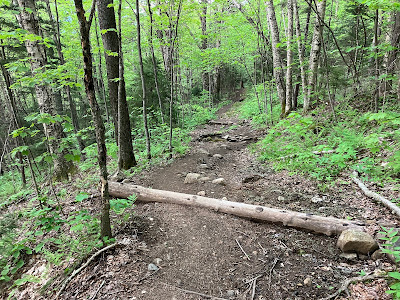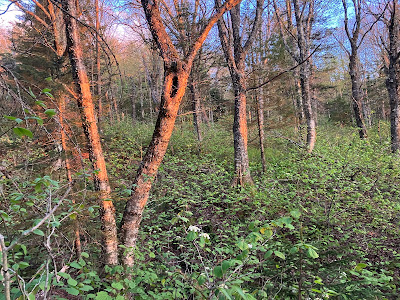As AMC White Mountain Guide co-editor, I wanted to check out the new trailhead situation for the Mount Kinsman Trail on the west side of the mountain. As many readers know, the trailhead that has been used since 2009 on a private land parcel has just been closed at the request of the landowner. The trailhead has been moved back to its former location at the Franconia/Easton town line on Rt. 116., next to the Tamarack Green Recreation center (formerly Tamarack Tennis Camps). When the trailhead was located at the town line up to 2009, there was only limited parking on the shoulder of Rt. 116. That would not be adequate for the amount of usage the trail receives today. Mike Kenney, the owner of Tamarack, and owner of one side of the land that the Mount Kinsman Trail crosses for its first 1.1 mile, has built a new parking area for the trail. He will be charging a parking fee of $10 for NH residents and $20 for out-of-state hikers, with a 50% discount for veterans. When this was announced it certainly generated a lively discussion on Facebook.
I had spoken with Mike Kenney on the phone a week earlier, and figured I would see him at the trailhead as he lives across the street and would likely be finishing up work on the parking lot. Before setting out on my hike, I had a chance to talk with both Jeffrey Lewis, property manager for Tamarack, and Mike Kenney. Mike emphasized to me that he is approaching the trailhead access from a conservation standpoint. (He is an avid birder and naturalist, and has purchased other land in the Easton valley for conservation purposes.) He wants to keep the land open to public use, but is concerned about the heavy usage on the trail across the land that he and his brother own. I assured him that the parking fee, especially for out-of-state hikers (which I agree is too high, but he's not budging on that), would surely cut down on the usage! I am expounding on this here to suggest that there is more to this fee than a simple "money grab," as it has been portrayed on some Facebook posts. We as hikers need to keep in mind that access to trails on private land is a privilege, not an entitlement, and nearly one-third of Mount Kinsman Trail is on Kenney family land. We have the option to hike elsewhere if we don't want to pay the fee. The alternative to a fee could be to close off access to the trail.
There is now signage at the former trailhead indicating that it has been closed.
The WMNF trail sign is now at the new parking area. There is also a hiker symbol and "Kinsman Trail" sign at the entrance on Rt. 116. The lot is accessed by a narrow gravel road that leads between two stone pillars.
The Mount Kinsman Trail begins as a woods road to the right of the trailhead kiosk.
Starting to the left of the kiosk is a new path cut by Mike Kenney, named the "Button Fern Nature Path." Mike says it's a good path for birding and nature observation as it leads through a variety of habitats. He notes that it is a "work in progress" , with further improvements needed. I headed up this way and, as expected, the first 1/4 mile was narrow and rough.
True to the name, some of the woods are quite "ferny."
The upper 1/4 mile of the path is pleasant walking on old woods roads.
The path comes out on the Mount Kinsman Trail just past the old sugarhouse.
After a long easy section the Mount Kinsman Trail makes a right turn as it enters the WMNF.
The Mount Kinsman Trail is fortunate to have Bruce Richards, one of the most dedicated trail volunteers in New Hampshire, as its longtime adopter (now a co-adopter - great to see him getting more help). A few years ago he and fellow members of the Trailwrights built this rock staircase.
I've always liked the ledgy crossing of this brook just past the site of the old Kinsman Cabin.
Nice waterbar next to an old yellow birch.
Foamflower was blooming in abundance along this section of trail.
Cascade at trail crossing of Mossy Falls Brook.
A pleasant climb through fine hardwood forest.
The spur to Bald Peak leaves at 2.1 miles, half the distance (though not half the elevation) to North Kinsman.
This yellow-blazed 0.2 mile side path is well worth the effort.
The broad open ledges of Bald Peak (2470 ft.) are a worthy destination for a half-day hike. North Kinsman looms close by to the SE.
View south to Mount Moosilauke, Mount Clough and the Benton Range.
I returned to the Mount Kinsman Trail and headed up towards North Kinsman, passing this patch of Painted Trilliums.
The Mount Kinsman Trail is noted for mostly moderate grades, with a few steep pitches, and even an occasional easy stretch like this.
There are rougher sections with slabs and roots.
A swath through the endless conifers.
Higher up is a relocation around a steep pitch that was abandoned. now seen as a mossy swath in the center of the photo.
Along the final angling ascent to the ridgecrest.
The Mount Kinsman Trail meets the Kinsman Ridge Trail at 3.7 miles, elevation 3850 ft.
There's a good view NE and east right by the junction.
The rough and rocky ascent (the only kind of ascent on the KRT) to North Kinsman features several scrambles up ledges, many of which always seem to be wet.
Hugging the edge here.
A scramble up to the left for this one.
Boot wedging action.
This pointy boulder is the high point of North Kinsman.
This ledge just down off the east side of the summit is one of the great viewing platforms in the Whites.
Cabot and Waumbek in the distance, Cannon and the Cannon Balls in close.
Lafayette, Lincoln and Little Haystack, of course, with Lonesome Lake nestled below.
Liberty and Flume, with Carrigain and Hancock peering over.
Zoomed.
An array of southern White Mountain peaks beyond spurs of South Kinsman.
To the left of the viewing platform, a somewhat tricky scramble down a six-foot ledge provides access to...
From here you get a fine view across to the great bulk of South Kinsman.
Best of all is the bird's eye view of Kinsman Pond, nestled at the base of the mountain's eastern cliffs.
After enjoying the summit views for an hour and a half, with nobody around, it was time to head down. I took a last look at Franconia Ridge from the Mount Kinsman Trail junction before dropping into the woods.
It was nice to be descending into the evening sun.
It was great to get back into the hardwoods after the long conifer tunnel.
This piney woods road is once again the lower part of Mount Kinsman Trail.
When I got back to the trailhead at 8:20, Mike Kenney was there, still working on the new parking lot. After a chat, it was time to head for home and a late dinner.























































































































